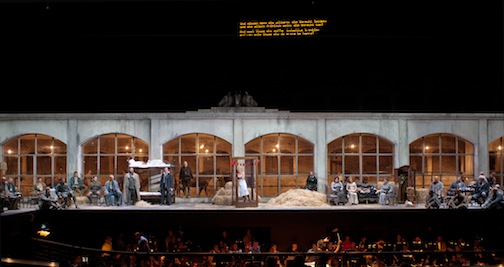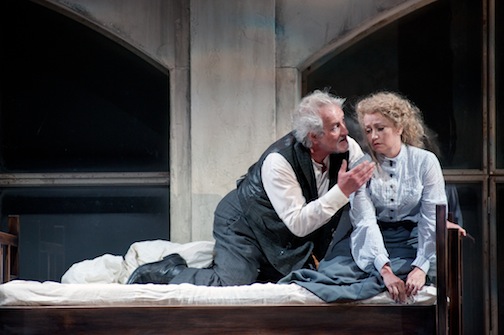By Irving Spitz
A complete all round intellectual experience
A major problem for classical music is the diminishing interest in the genre reflected by sparse attendances at concerts. In an attempt to counteract this phenomenon, many musical organizations, including those in Israel, include introductory pre-concert lectures to familiarize the audience with the works to be played.
The acclaimed Israeli Carmel quartet takes this a step further. In their appearances all over Israel, they have an explanatory lecture not as a preconcert format, but as an integral part of the performance. This innovative programming is often scheduled on successive evenings so that the lecture can be given in both Hebrew and English.
The Carmel quartet was originally established in 1999. Its members include Rachel Ringelstein (first violin), Liah Raikhlin (second violin), Yoel Greenberg (viola) and Tami Waterman (cello). Individually, each of these four outstanding musicians has been the recipient of many prestigious honors and prizes.
Today, the Carmel Quartet is generally acknowledged to be one of the foremost Israeli chamber groups. Since their founding, they have garlanded several international awards and have performed to rave reviews in Israel, as well as throughout Europe and the USA either alone or together with other world-renowned musicians.
Franz Schubert died in 1828 before his 32nd birthday. Throughout his short life, he was under the influence of Beethoven who passed away in 1827. Many musicologists believe that Beethoven's death unleashed in Schubert a burst of creative activity, almost unprecedented in the history of music.
During the last year of Schubert's short life, compositions flowed endlessly from his pen. They include the incomparable song cycle, Winterreise, another large collection of songs, a mass, several other choral works, completion of his great symphony in C, the last three piano sonatas, a group of piano impromptus, his fantasia for two pianos and the great incomparable string quintet in C major, D 956. The latter is scored for two violins, viola, and two cellos and was completed just two months before the composer's death. It only received its first public performance 22 years later. This is really astounding since this supreme masterpiece is acknowledged by many as representing the peak of the chamber music repertoire.
Schubert's quintet was featured as the backbone of the most recent concert of the Carmel Quartet in the auditorium at the Jerusalem Music Center. The entertaining yet sophisticated lecture given by musicologist, Yoel Greenberg who is also the quartet's violist, explained how the second movement's plaintive mood makes it popular as background for film, poetry and literature. He cited several cogent examples with film clips and literature readings by members of the quartet. As Greenberg pointed out, the incomparable pianist, Arthur Rubinstein himself described this adagio movement as the "entrance to heaven" and requested that it be played at his funeral.
The first half of the concert ended with a short "quartet for a missing cellist," specially commissioned from the Israeli composer, Gideon Lewensohn as homage to the Schubert Quintet. As the final strains of this innovative work ended, it was replaced by the steady beating of a metronome, perhaps indicative of music's timeless quality.
Cellist Hillel Zori joined the Carmel Quartet for the performance of the quintet. The musicians began with beautifully nuanced, lush, swelling fortissimo chords that usher in the work. In the second movement adagio, the string players mustered the required tranquility of the sublime first theme. Especially effective was the trio of second violin, viola, first cello accompanied by the pizzicato from first violin and second cello. The audience were held in thrall waiting for each succeeding note. This was followed by the intensely turbulent middle section finally reverting back to the quiet contemplative mood with which the movement began.
In the hands of the Carmel quartet, the dramatic symphonic-like third movement scherzo was a real contrast with the previous adagio. It was hard to believe that the volume of sound emanated from only five string instruments. The quartet brought out all of the mood contrasts of this sophisticated movement. Finally, they successfully captured the ebullient Viennese and Hungarian dance motives of the final allegretto, which brought the most memorable concert to a conclusion.
The article was originally published in part in Esra Magazine, Issue 176, September 2014
The Intermezzo concert series hosted by the Israel Philharmonic Orchestra (IPO) in Jerusalem's Sherover Theater is a highly popular event. In addition to the music, concerts also feature an introductory lecture explaining the works to be played as well as coffee and cake. Whether the culinary component is the main reason for the popularity of these concerts remains conjectural!
This concert provided the best that one comes to expect from the IPO. The conductor was American born Kent Nagano, currently the music director of the Orchestre Symphonique de Montréal. In 2015 he will take up the position of music director of the Hamburg State Opera.
The concert began with Georges Bizet's Symphony in C Major. Bizet composed this masterpiece at the tender age of 17 years in about one month while he was studying at the Paris Conservatoire under the composer Charles Gounod. Only Mozart, Mendelssohn and Schubert showed such precocious talent at a similar age.
The orchestra was initially a little unsettled but rapidly moved into top gear and under Kent Nagano gave an ebullient rendering of the score. Especially noteworthy was the beautiful oboe playing in the second theme of the first movement. Mention should also be made of the haunting oboe melody in the Adagio slow movement accompanied with pizzicato by the strings.
Next on the program was Paul Dukas's symphonic poem, The Sorcerers Apprentice based on a ballad by the great German writer Johann Wolfgang von Goethe. Lecturer Michael Wolpe pointed out that Dukas was Jewish and that his oeuvre was very small. He was so highly self- critical that he destroyed many of his compositions.
The Sorcerer's Apprentice is Dukas's best known composition and relates how in the sorcerer's absence his apprentice attempts to emulate his master and persuades a broomstick to carry buckets of water for him. The situation rapidly gets out of control since the broom brings in so many buckets that the house is flooded. The apprentice chops the broom in half with an axe but to his horror both pieces come to life and continue to fetch water at an even greater pace. Eventually the sorcerer returns to this chaos and breaks the spell.
This work was popularized by Walt Disney in his famous animated 1940 movie Fantasia. It was Mickey Mouse who took the role of the apprentice. Kent Nagano did a masterful job highlighting the virtuosity of the IPO. There were superb contributions by trumpets, bassoons, bass clarinet and percussion.
The real pièce de résistance of the concert was a performance of Tchaikovsky's ever popular first piano concerto. After completing the concerto, Tchaikovsky approached the Russian pianist and conductor, Nikolai Rubinstein to premiere the work. He also played it for Rubinstein. What followed was one of the most famous confrontations in the annals of music. According to Tchaikovsky's own written account, Rubenstein said "the concerto was worthless and unplayable; passages were so fragmented, so clumsy, so badly written that they were beyond rescue ......" Rubinstein added that if the concerto was completely revised according to his demands, then he would play it. Tchaikovsky replied that he would not "alter a single note" and approached German pianist Hans von Bülow who premiered the original version in Boston. The rest is history. Rubinstein subsequently revised his opinion, became an ardent admirer of the work and conducted its Moscow premiere.
The soloist in the performance in Jerusalem was pianist Daniil Trifonov, who won 3rd prize in the International Chopin Competition in Warsaw in 2010 and the following year first prize in the Arthur Rubinstein Competition in Tel Aviv and the International Tchaikovsky Competition in Moscow.
Trifoniv pays on a Fazioli piano. The Italian company manufacturing these pianos was established in 1981 and a little over 100 hand built pianos are produced annually. Many established pianists have expressed their preference for these instruments and an increasing number use these Italian pianos in concert performances.
Crouching over the piano, Trifonov gave a dazzling, impeccable, authoritative and majestic account of this ever popular war horse. This was not only a flashy virtuosic display but a deeply probing account where he succeeded in capturing the subtle nuances of this score. I would like to hear this prodigiously gifted pianist in the non-romantic classical repertory to see if his unique talents also extend to this genre. As an encore, Trifonov gave a scintillating account of Chopin's "Grande valse brillante" Op. 18 in E-Flat.
-The article was originally published in part in Esra Magazine, Issue 176, September 2014
A great historic site for a memorable music festival
Ravenna, a city in Northern Italy situated just off the Adriatic Coast has a unique and unmatched collection of Byzantine Mosaics. Because of this treasure trove, Ravenna boasts eight UNESCO World Heritage sites and is a strong candidate to be selected as the European city of Culture in 2019.
This jewel of a city also hosts an annual musical festival. This year, the Czech Philharmonic Orchestra was one of the visiting ensembles. They were conducted by the incomparable Valery Gergiev. The piano soloist was Yeol Eum Son, an extraordinary South Korean virtuoso. She gave a scintillating account of Rachmaninov's second piano concerto, her playing being characterised by rich and varying coloring. The power emanating from the petite pianist in the fortissimo passages of this romantic piano concerto was formidable.
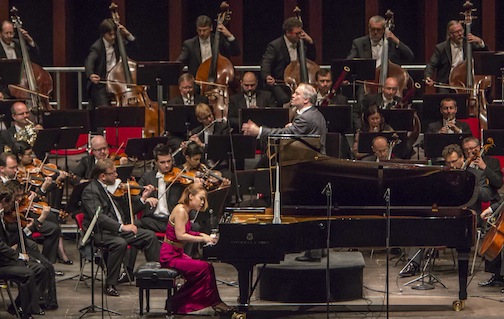
Czech Philharmonic Orchestra with Valery Gergiev (Conductor) and Yeol Eum Son (pianist) © Maurizio Montanari
Two other Russian works rounded out the program. A suite from Tchaikovsky's Swan Lake and Mussorgsky's Pictures at an Exhibition. The orchestral concert was held in the Palazzo Mauro de André, a large covered sports stadium. I was sceptical about the acoustics. Whilst certainly not perfect they were adequate. Even the brass and percussion sections in The Great Gate of Kiev, from Pictures at an Exhibition sounded impressive. Gergiev coaxed from the orchestra all the intricate inner details of the work. The lovely lush warm string playing characteristic of great central European orchestras was much in evidence.
Many of the concerts at the annual Ravenna festival feature The Luigi Cherubini Youth Orchestra, named after the Italian composer Luigi Cherubini. The orchestra was founded in 2004 by the conductor Riccardo Muti who is its musical director. The orchestral members whose ages range from 18 to 27 years come from all over the European Union.

The Luigi Cherubini Youth Orchestra with Kent Nagano (conductor) and Till Fellner (pianist). © Zani Casadio
There is always something special about hearing a group of enthusiastic young musicians. These proficient players gave a mature exciting account of Brahms's fourth symphony. This inspiring performance was conducted by Kent Nagano, who successfully achieved the appropriate balance and clarity with his orchestral forces. The concert began with Brahms's first piano concerto. The soloist was Austrian pianist Till Fellner. This deeply committed musician gave a slow measured but authoritative account of this technically daunting work.
The festival often includes a full opera production held in Ravenna's beautiful opera house, Teatro Alighieri. This year, OperaUpClose, a British Group which produces modern budget adaptations made an appearance. The venue was a restaurant where the audience were first served a delightful meal. The performance thus took on a cabaret like atmosphere.
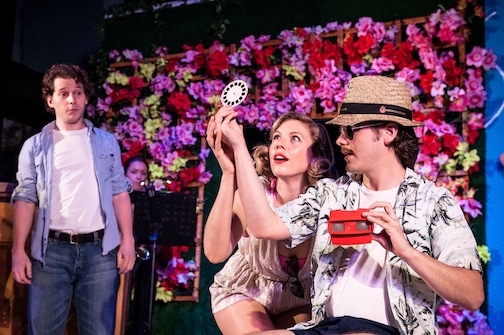
Act 1 Donizetti's L'Elisir D'amore with Prudence Sanders (Adina), Alex Vearey Roberts (Nemorino) and Richard Immergluck (Belcore) © Anna Agliardi
The opera performed was Donizetti's ever popular L'Elisir D'amore in an updated and abridged English version by Thomas Eccleshare and it was produced by Valentina Ceschi. Kate Lane's small-scale innovative production was set in 1950 Hollywood around a swimming pool party hosted by the blonde starlet, Adina, sung by Prudence Sanders who possesses a lovely light silvery voice. Tenor Alex Vearey Roberts sang the role of the love struck pool attendant, Nemorino with ardour and flair. Richard Immergluck was Belcore, the dashing officer who seeks Adina's attention. Dickon Gough was the quack Dulcamara who sells to the gullible and simple Nemorino a love potion or elixir of love which in reality is a cheap bottle of Bordeaux. These singers also maintained the uniform high vocal standard. Musical accompaniment was provided by piano, viola and saxophone. This endeavor, more cabaret than serious opera, was certainly very entertaining. The audience left happy and smiling. The evening was a great success for the Ravenna Festival.
New York, Helsinki, Berlin and Barcelona audiences will have the privilege of seeing this landmark production
Opera companies worldwide are currently celebrating the 150th anniversary of the birth of Richard Strauss. His Elektra was recently staged at La Scala in a production originally directed by Patrice Chéreau. This great director passed away last October His forays into this medium were not all that frequent. His landmark production of Wagner's Ring in 1976 at the Bayreuth festival was initially reviled but eventually acclaimed as one of the most dramatic Ring's of all time. Elektra was Chéreau's last operatic creation and debuted to great acclaim at France's 2013 Aix festival.
The plot, based on Hugo von Hofmannsthal's play relates to the obsession of Elektra to avenge her father Agamemnon who was murdered by her mother, Klytämnestra, and her mother's lover, Aegisth.
The curtain rose to silence with Klytämnestra's servants performing their mundane tasks of sweeping and cleaning the palace. Then suddenly without warning came the dramatic orchestral entry. This powerful beginning was absolutely spell-binding. Vocally, pride of place goes to Evelyn Herlitzius, who gave a towering, riveting and totally committed portrayal of Elektra, one of the repertory's most challenging roles. Dressed in loose-fitting pants and a T shirt, this consummate actress danced round like a woman possessed, emphasizing that her sole raison d'être was to avenge her father's murder.
Klytämnestra, the odious mother usually projects hatred. Here, mezzo soprano, Waltraud Meier, rendered her as more humane, possibly even too sympathetically. Meier's interpretation was somewhat subdued and on occasion, her voice was drowned out by the massive orchestral forces.
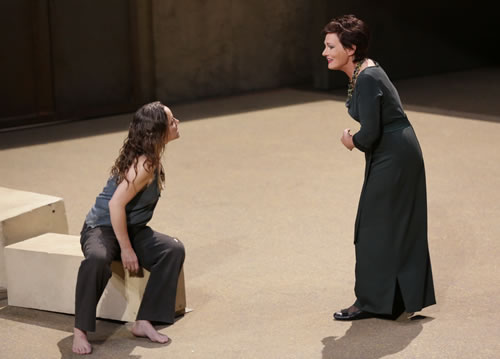 Evelyn Herlitzius (Elektra) and Waltraud Meier (Klytämnestra) in Richard Strauss's Elektra. Credit Brescia/Amisano - Teatro alla Scala Evelyn Herlitzius (Elektra) and Waltraud Meier (Klytämnestra) in Richard Strauss's Elektra. Credit Brescia/Amisano - Teatro alla Scala
Adrianne Pieczonka was also very effective as Elektra's more feminine sister, Chrysothemis. She is the only member of the dysfunctional family who is able to muster emotional feelings of hope and love. She wants nothing more than to escape from the palace, lead a normal life and have children. She brought out tenderness and pathos in her outstanding portrayal of the role. But all her entreaties to Elektra were of no avail.
Rene Pape took on the role of Orest, the third sibling. Prior to curtain rise it was announced that he had some vocal problems but nevertheless agreed to perform. This was a mistake and this incomparable bass did credit neither to himself nor his audience.
The smaller secondary roles were exemplary. These included Donald McIntyre as an old servant, the 90 year old Franz Mazura as the guardian of Oreste, and soprano Roberta Alexander as the Fifth Maid. Finish conductor, Esa-Pekka Salonen succeeded in bringing out all the dramatic dissonances inherent in the score. The orchestral accompaniment was truly magnificent.
One of the most dramatic climaxes occurred when Elektra realizes the intruding stranger is her brother, Orest. In this poignant scene one could feel the weight of responsibility removed from Electra as "big brother" will now take matters in hand and mete out the appropriate punishment on their mother and her lover. In most productions, Elektra dances herself to death after the murder of her mother and Aegisth. Not this time. Here she remains seated, immobile, frozen in time in a trance. A dramatic finale to a shattering performance.
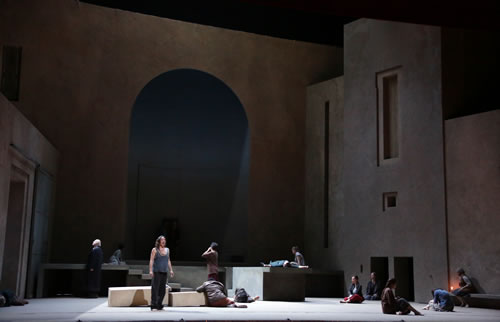 Concluding scene of Richard Strauss's Elektra. Credit Brescia/Amisano - Teatro alla Scala Concluding scene of Richard Strauss's Elektra. Credit Brescia/Amisano - Teatro alla Scala
Impressive and thought provoking museum exhibits are so unique and special that they warrant a dedicated trip to view them. What follows is a summary of the most memorable 2013 artistic events I attended, led by the most outstanding - The Herod exhibit at Jerusalem's Israel Museum.
Herod the Great: The King's Final Journey: This notable show deserved all accolades for its content and extraordinary curatorship. It was the first ever exhibit dedicated to Herod, the greatest builder in Jewish history. Indeed, Herod's main legacy lies in his massive building projects. This ambitious exhibit was seen by over 450,000 visitors, an Israel museum record.
In 2007, after a 40-year search, archaeologist Professor Ehud Netzer discovered Herod's tomb at Herodion, a palace fortress that the king had built on the edge of the Judean Desert. Herodion also included gardens, pools, decorated bathhouses and a theatre. After discovering the tomb, Netzer broached the idea of this exhibit with the Israel Museum. Tragically, he died in 2010 after sustaining a fall at Herodion. Fittingly this milestone exhibit was dedicated to his memory.
The museum utilized computer-generated models of Herodian palaces in Jericho as well as his massive building projects in Caesarea, Masada and Herodion. Emphasis was also given to Herod's renovation and re-construction of the Temple in Jerusalem, reputed to be the largest and most magnificent building of its kind in the Roman world.
The exhibit shed new light on the political and aesthetic influence of the controversial king. It emphasized the delicate relationship between Rome and Judea attesting to Herod's political savvy. Originally a protégé of Mark Antony, Herod switched sides to Octavian (Augustus) when the latter defeated Antony. In the exhibit there were busts of Herod's Roman contemporaries, including Augustus and his wife Livia, his friend Marcus Agrippa as well as Mark Antony and Cleopatra.
On view were many reconstructed palace rooms decorated with stucco, restored frescoes and mosaics. In total, there were about 250 artifacts, many of which had never been previously exhibited. There were remarkable wall paintings including a nautical scene with ships in battle. There were also carved stone fragments from the Temple Mount, an imperial marble basin believed to be a gift from Augustus to Herod and a huge stone bathtub which had been unearthed in Cypros, one of his palaces overlooking Jericho. In the display of amphorae, there were several with inscriptions indicating that they contained wine, fruit or fish sauce. Many of these delicacies had been imported.
The centrepiece was a monumental, full-size reconstruction of Herod's mausoleum. It featured stone blocks excavated at the site with Ionic columns and intricate cornices. This edifice weighed some 30 tons and the museum had to strengthen the gallery foundations to support this weight.
Fig 1: Herod's reconstructed mausoleum
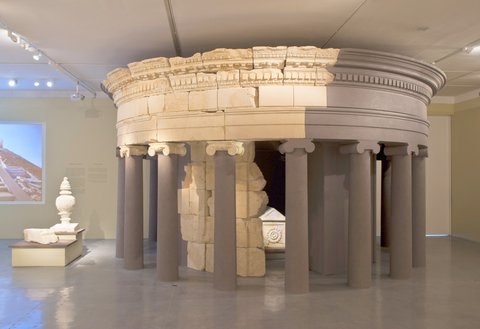
Elie Posner
The Israel Museum, Jerusalem,
Three shattered limestone sarcophagi were found in the tomb's vicinity. The most elaborate was intricately carved from expensive reddish limestone. It had been deliberately and almost totally destroyed soon after its construction but was painstakingly restored for the exhibit. This sarcophagus was placed inside the burial chamber and may possibly have held Herod's body.
The exhibit is accompanied by an outstanding scholarly catalogue edited by Silvia Rozenberg and David Mevorah. The museum staff toiled for over 3 years to bring this once in a lifetime show to fruition. The results represent an artistic triumph for Israel in general and the Museum and its director, James Snyder, in particular.
Cleopatra, Rome and the Magic of Egypt: Rome's Chiostro del Bramante hosted this show which ideally complemented that of Herod in Jerusalem. It analysed Cleopatra's relationship with Rome and that city's fascination for Egypt. The charismatic queen, Cleopatra, a contemporary of Herod, was barely 20 when she seduced Julius Caesar and subsequently Mark Antony. Highly intelligent, she spoke at least seven languages including Hebrew and Aramaic. The 180 masterpieces on show include frescoes, mosaics, funerary urns, coins, sculptures and jewellery.
Fig 2: Head of Cleopatra, the "Nahman" Cleopatra
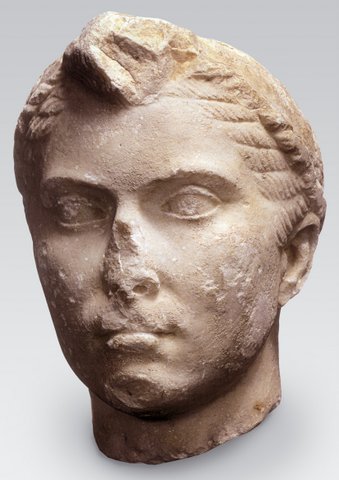
Private collection
Leonardo da Vinci: The Universal Man: This show-stopper was featured in Venice's Gallerie dell'Accademia and highlighted 52 of Leonardo's graphic works. Because of their fragility and sensitivity to light, this was the first time since 1980 that the entire Accademia's collection was on display. There were also loans from other great museums. Pride of place went to the renowned Vitruvian Man, a representation of the union of art and science, one of the greatest icons of Western Art. In addition to studies of the human body, the exhibit also featured preparatory drawings for Leonardo's lost painting, the Battle of Anghiari as well as sections on botany and weapons. The latter illustrated another facet of Leonardo's versatility, that of a designer of arms.
Fig 3: Leonardo da Vinci
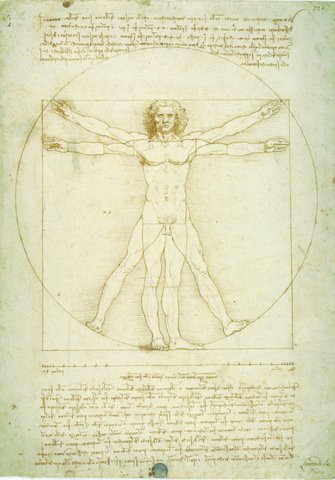
The Vitruvian Man
Gallerie dell'Accademia, Venezia.
Venice's 55th Biennale: This is arguably the most prestigious and influential international contemporary art event. This year, 88 countries participated. It would have required many days to do justice to this massive show. Three pavilions were especially noteworthy. Germany featured an installation by Ai Weiwei, the Chinese artist who because of his political views has had several run-ins with the Chinese authorities. His intriguing exhibit entitled Bang comprised a forest of 886 three legged wooden stools. Such stools have a typical local Chinese flavour and have been used there for centuries.
Britain's contribution was designed by artist Jeremy Deller. It took subtle aim at England's social, political and economic society. It stretched back to Palaeolithic times with a display of ancient hand axes. A contemporary painting featured a colossal figure of William Morris, the Victorian socialist and designer, hurtling Russian tycoon Roman Abramovich's yacht into the Venetian lagoon.
In the Russian pavilion, Vadim Zakharov also created an installation highlighting the political and social milieu of the new Russia. It was based on the Greek mythological story of Danae, who despite being imprisoned in a tower was still impregnated by Zeus who appeared in the form of golden rain. Gold coins rained down from the ceiling on women visitors protected by umbrellas; men were barred from this area but could view the proceedings from a balcony. A rather grave unsmiling bureaucrat collected the coins with a bucket, placed them on a conveyor belt which transported them to the roof. The flow of cash began again...
The Frick Collection: The Royal Picture Gallery, Mauritshuis, in The Hague, loaned the Frick 15 paintings from the 17th Century, the Dutch Golden Age which comprised portraits, still-lifes, landscapes as well as biblical and genre scenes. The most dramatic painting was The Goldfinch by Carel Fabritius, a most talented artist and pupil of Rembrandt, whose life was tragically cut short by a gunpowder explosion which destroyed much of Delft. The brilliant trompe l'oeil effects in this unique gem are remarkable.
Another eye-catcher was Rembrandt's Susanna. According to the book of Daniel, the virtuous Susanna was spied upon by 2 Babylonian Elders, whilst taking a bath. This is one of art's supreme examples of voyeurism. The unfortunate Susanna, desperately trying to shield her body, is not idealized but the anguish on her face is readily evident as the two elders leer in the background. Another three stunning paintings by Rembrandt were also part of the exhibit.
Pride of place, however, went to Johannes Vermeer's Girl with a Pearl Earring. The pensive enigmatic girl is one of the great icons of western art and is the Dutch equivalent of the Mona Lisa. The sitter remains unidentified and thus the painting is a tronie, which represent an idealized character. Ironically this painting was purchased in 1881 for less that $5.
Figure 4: Johannes Vermeer (1632-1675)
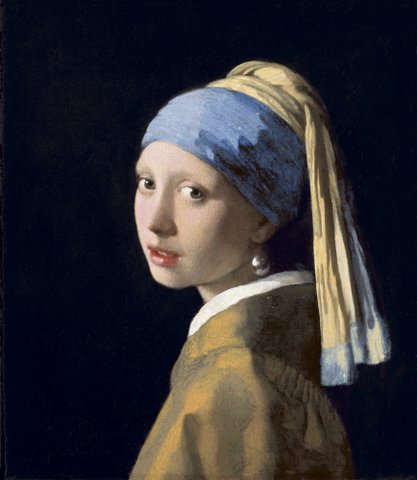
Girl with a Pearl Earring, c. 1665
Oil on canvas
Royal Picture Gallery Mauritshuis, The Hague
Other masterpieces from the Mauritshuis included those by Hals, Steen, Terborch, and van Ruisdal amongst others. The Dutch exhibit complemented the Frick's three genre scenes by Vermeer making this museum an obligatory pilgrimage for Vermeer lovers in 2013.
Morgan Library and Museum: Here one was privileged to see another iconic portrait, The Head of a Young Woman by Leonardo da Vinci. This metal point drawing served as a study for the angel in Leonardo's great painting, The Virgin of the Rocks described by art historian, Kenneth Clark as one of the most beautiful drawings in the world. This was part of the collection from the Biblioteca Reale, Turin which also showcases Leonardo's Codex on the Flight of Birds. Of particular interest are the artist's annotations in his left handed backward mirror script.
Figure 5: Leonardo da Vinci (1452-1519)
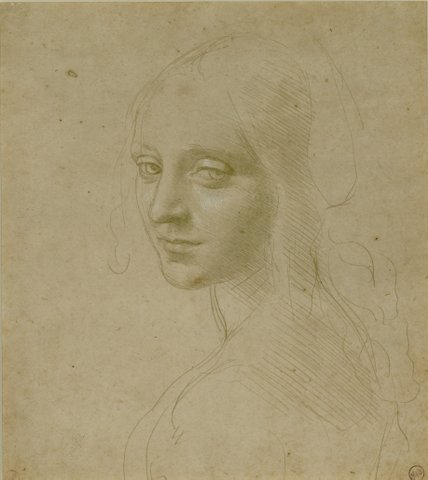
Head of a young woman, 1480s
Metal point
Biblioteca Reale, Turin
The New York Historical Society: They mounted The Armory Show at 100 to celebrate the centenary of this seminal event, one of the key art exhibits ever held in the US since it introduced European avant-garde to America. Th4 original exhibit opened in New York in February 1913 and approximately 87,000 people attended the one month event.
The Historical Society has reunited more than 100 paintings of the original 1,350 works displayed. Half the artists in the original show were American. European artists represented included Brancusi, Braque, Cezanne, Degas, Duchamp, Gaugain, Lautrec, Matisse, Munch, Picasso, Picabia, Renoir, Rousseau and van Gogh. The best selling artist was Odilon Redon.
Many of the paintings exhibited in 1913 were new and unconventional and provoked derision from critics and public alike. Marcel Duchamp's Nude Descending a Staircase (No 2) was regarded as the most scandalous of all and attracted the most attention. Matisse's Blue Nude considered today as one of the prized paintings in the Baltimore Museum of Art, was also regarded as primitive and depraved. A scholarly catalogue accompanies the exhibit.
Figure 6: Henri Matisse (1869-1954)
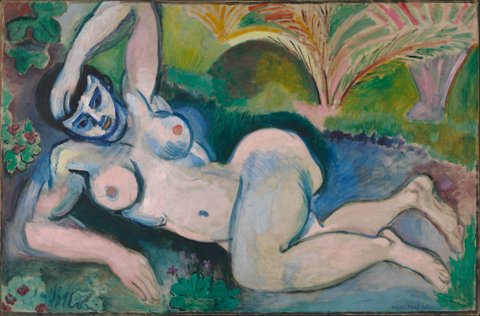
Blue Nude, 1907
Oil on Canvas
The Baltimore Museum of Art
© 2013 Succession H. Matisse/Artists Rights Society (ARS), New York
Neue Galerie: The exhibit, Vasily Kandinsky: From Blaue Reiter to the Bauhaus (1910-1925) highlighted more than 80 works and included paintings, drawings and decorative materials. It was drawn from the Neue Galerie's own collection with generous loans from major museums and private collections. Key works by Kandinsky's contemporaries including Gabriele Munter, Franz Marc and Paul Klee amongst others are also on display.
The exhibit traced the development of the artist over this fifteen year period. Born in Moscow, Kandinsky only began painting at the age of 30 when he settled in Munich. It was there that he and his colleagues formed Der Blaue Reiter (The Blue Rider) movement. The name was coined by Franz Marc who loved horses and Kandinsky who had an infatuation with the color blue as well as riders. Kandinsky's paintings from this period were initially romantic and expressionistic with rainbow colors. He gradually abandoned this free dynamic brushwork and representation altogether creating a completely non-objective style. With the outbreak of World War 1, Kandinsky returned to Russia where he devoted his time to teaching.
In 1921, Kandinsky joined the Bauhaus school in Weimar. It was here that he developed his geometric style which evolved into pure abstraction. Kandinsky was much influenced by music, particularly by that of Arnold Schoenberg and he often used musical terms such as improvisations, fugues and compositions to identify his works.
Kandinsky believed that art, music and theatre, the so-called Gesamtkunstwerk (Total work of art) were all connected. Central to the exhibition is a special reconstruction of Kandinsky's lost murals for the Juryfreie Kunstschau (Jury Free Art Show) held in Berlin in 1922. This project was designed by Kandinsky and executed by his Bauhaus students.
Figure 7: Vasily Kandinsky (1866-1944)
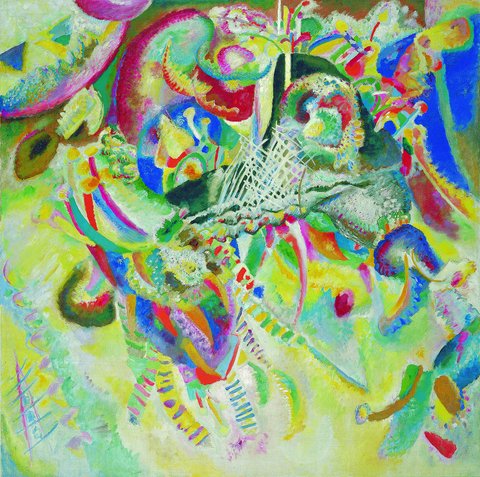
Fugue, 1914
Oil on Canvas
Fondation Beyeler, Riehen/Basel
Grand Hotel: Redesigning Modern Life, another memorable show could be seen at Vancouver's Art Gallery. It centred on themes of travel, design, culture and social interactions by charting the evolution of the hotel from its origins to its establishment as a major cultural phenomenon. The exhibit showed how the hotel had been a fertile environment for art, literature, music, film, poetry and science. Sigmund Freud and Richard Wagner worked in the café at Vienna's Hotel Imperial whilst influential cultural figures gathered at New York's Algonquin and Chelsea Hotels.
This exhibit demonstrated that after the Second World War, the US government believed that American style hotels could bolster economic and political stability in the face of Soviet expansionism. The US actually financed some of the Hilton hotel constructions in Cairo, Teheran, Istanbul and Tel Aviv through the Marshall Plan, the aid program which rescued European economies after the War.
This review was published in part in The Jerusalem Post on 15 December, 2013 and 9 February 2014.
The ultimate verisimo opera
Umberto Giordano's opera, Andre Chenier is set during the French Revolution. It is a love story based on the life of a real historical character, the poet Andrea Chenier. He was initially an ardent supporter of the revolution but subsequently became a victim of the Reign of Terror and was guillotined. The main female protagonist, the young aristocrat Maddalena, falls passionately in love with Chenier. She eventually takes the place of another woman so that she could be guillotined with her lover. The other main character, Carlo Gérard, once a servant in the service of the aristocratic household of Maddalena's mother, becomes a revolutionary ringleader. He has always been hopelessly in love with Maddalena and falsely denounced the poet to the Revolutionary Tribunal.
A great tenor, soprano and baritone are required for a successful performance of this work. The Vienna State Opera provided the necessary goods. The Argentinean tenor Jose Cura proved to be a passionate Andre Chenier although his voice has lost some of its sheen and he lacks the Italianate tenor qualities one associates with the great exponents of the role which included Maria Del Monaco and Franco Corelli.
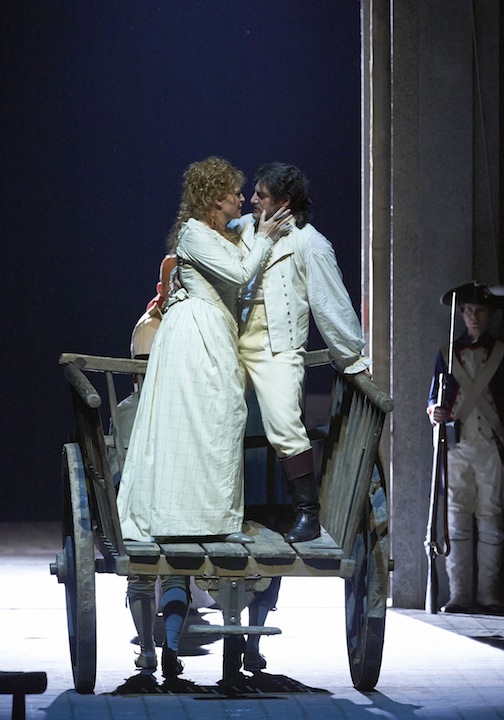 Tenor Jose Cura and soprano Martine Serafin in Umberto Giordano's Andrea Chenier. Tenor Jose Cura and soprano Martine Serafin in Umberto Giordano's Andrea Chenier.
Credit: Wiener Staatsoper / Michael Poehn.
Viennese soprano Martine Serafin successfully sung the hapless role of Maddalena. She began somewhat tentatively but rapidly settled in and her voice demonstrated the soaring lyricism which is an essential component of the role. The Italian Marco Vratogna's rich and commanding baritone voice was the real standout. In his gripping Act 3 monolog, he realizes that the ideals for which he fought have turned into lies and he decries the excesses of the revolution. His voice reflected the pathos, irony and moment of truth. This aria was one of the real highlights of the evening. Italian conductor Marco Armiliato led the Orchestra of the State Opera in a most elegant reading of the score and provided all the necessary support for the singers.
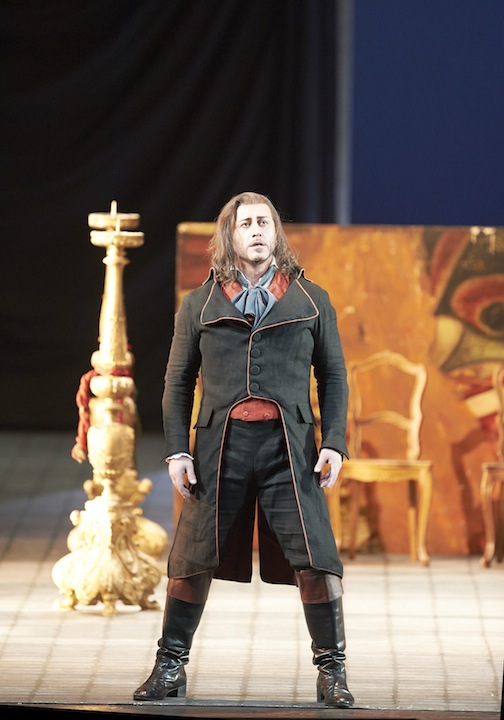 Barione Marco Vratogna in Umberto Giordano's Andrea Chenier. Barione Marco Vratogna in Umberto Giordano's Andrea Chenier.
Credit: Wiener Staatsoper / Michael Poehn.
Otto Schenk's production with its conventional staging is somewhat dated and uninteresting. I recalled David Fielding's spectacular settings of this opera last year at Austria's Bregenz festival. The Vienna State Opera deserves something better.
This article was published in part in The Jerusalem Post, June 2, 2013
Salzburg, the birthplace of Wolfgang Amadeus Mozart, has treated its most illustrious son far better in death that it did during life. Indeed, through shrewd public relations and astute marketing, the city has become a magnet for music lovers and the summer festival with its impeccable musical standards represents the Olympus of all festivals. It also has the dubious distinction of having the highest ticket prices.
This year was the inaugural season of the newly appointed festival director, Alexander Pereira, who relocated from the Zurich Opera. At the outset of his tenure, he stated, "I am convinced that a festival should be unique each year." The mainstay of the Salzburg festival remains the operatic productions and Pereira revolutionized this format. No longer will previous productions be repeated. The plan is to have new productions at each festival. Even more impressive is Pereira's intention of staging annually a newly commissioned opera. Funding for this ambitious undertaking has already been secured until 2016. György Kurtág, Hungary's leading composer, will premiere a new composition at next year's festival.
Since there was inadequate time for a new commission during the current festival, Pereira staged Bernd Alois Zimmermann's epic opera, Die Soldaten. Acknowledged as one of the major operatic compositions of the last 50 years, it has been very infrequently performed because of its notoriously difficult vocal and orchestral demands as well as the complex staging. Pereira selected Latvian stage and set director, Alvis Hermanis, who pulled out all the stops to make this landmark production the absolute highlight of the current festival.
Hermanis set the action during the First World War. The opera portrays the degradation of the main character, Marie, the naive daughter of a working class family who takes up with the young French nobleman, Desportes, believing that he will marry her. She abandons her fiancée, the draper Stolzius with whom she is still in love. Maria's father, Wesener, initially warns her against her liaison with Desportes but then relents and even encourages her, believing that Marie could marry above her class. Desportes cynically exploits Marie and then rapidly discards her. Marie gradually becomes the soldier's whore, flitting from one soldier to another. Stolzius gets his revenge by poisoning Desportes. However this was only a pyrrhic victory since Stolzius also poisons himself. Marie eventually ends up in the gutter where she begs for a morsel of bread from her father who fails to recognize her.
The opera was performed in the former Felsenreitschule (Rock Riding School), a magnificent theater carved out of the rocks, which was used in the 1600s as a riding school. The staging comprised nine large window arches effectively dividing the huge stage into compartments. The background behind these windows depicted the horrors of war. Dissolute soldiers and other interested and disinterested onlookers viewed the proceedings. They often wandered around aimlessly, lay on beds, drank alcohol and cajoled with women. Seven horses paraded up and down, which added a nice touch considering the previous function of this theater.
Projected onto the stage were early pornographic daguerreotypes. Thus both the audience upfront and the soldiers behind the windows become voyeurs. Is this pornography or art? It was left to the audience to decide. On several occasions, the action calls for several scenes to be set simultaneously and the ingenious staging brilliantly exploited and allowed for this.
With the horses came plenty of hay and much of the action was played in a vertical glass cabinet box filled with hay. In one three-part tableau, there was Stolius's mother pleading with her son to forget Marie. Adjacent was Wesener's aged mother singing a folk song and in the third scene were Marie and Desportes having their initial sexual encounter in the cabinet box. It was also here that Marie was subsequently raped by Desportes's gamekeeper. In another dramatic moment, Maria was entrapped alone in the glass box struggling to escape her fate but of no avail.
Another pivotal scene saw an image of Marie negotiating a tightrope and walking across the giant stage accompanied by an organ interlude. Did this symbolize or imply her impending danger and irrevocable downward spiral? In a final remarkable twist at the end of the opera, one saw Marie high up on the stage clasping stone images of three horses from the Riding school.
The role of Maria was played by American soprano Laura Aikin, who summoned all her resources to give an outstanding singing and acting portrayal of the complex role. Other memorable performances in the huge cast were given by baritone Alfred Muff as her father. Bass-baritone Tomasz Konieczny was also most effective as Stolzius as was tenor Daniel Brenna in the role of the despicable Desportes. Another notable performance was that of veteran soprano Gabriela Beňačková as the Countess who invited Maria to live with her to prevent her son from forming too close a liaison with the soldier's whore.
In the pit was the Vienna Philharmonic Orchestra, augmented on both side walls by massive percussion forces which included organ, piano, harpsichord and harps. Full marks go to conductor Ingo Metzmacher who held these gigantic forces together and led a scintillating reading of the complex 12-tone score.
Puccini has been given short thrift throughout the history of the Salzburg Festival. To date, his only operas to have been performed have been Tosca and Turandot. Pereira staged La Boheme, which proved to be the most popular opera at the current festival. This was no doubt related to the presence of Russian superstar soprano Anna Netrebko who portrayed the hapless Mimi. The crowds were so dense that it was difficult to cross the road separating the non-fashionable side of the Grosses Festspielhaus (Great Festival Hall) crammed with gaping onlookers from the fashionable side with the ticket holders resplendent in fancy evening attire.
Netrebko did not disappoint and gave a lustrous, totally committed portrayal of the doomed Mimi. Her vocal control in the pianissimo passages was quite remarkable. Tenor Piotr Beczala as her Rodolfo also gave an impassioned performance as did Massimo Cavalletti in the role of Marcello and soprano Nino Machaidze as Musetta. Bass Carlo Colombara as Colline made a great show of his one great aria when he is about to pawn his coat.
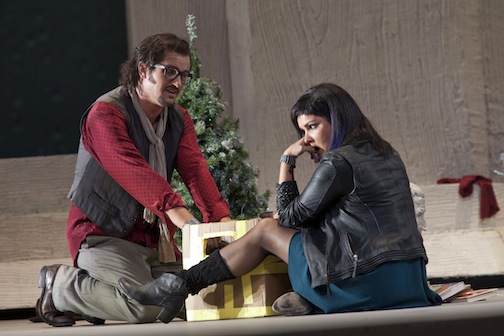 Daniele Gatti propelled the Vienna Philharmonic with much vigor. This was orchestral playing at the highest level. This production, directed by Damiano Michieletto was set in contemporary Paris. In many instances maps of the city were prominently displayed together with small buildings. The Bohemian garret scene utilized the entire stage of the Grosses Festspielhaus and lost its intimacy. The Latin Quarter scene was crowded with wealthy Christmas shoppers which dramatically contrasted with the poverty of the opening scene and that of Act 3 set in the outskirts of Paris at a road house selling snacks with the coming and going of workers, trash collectors and women of the night.
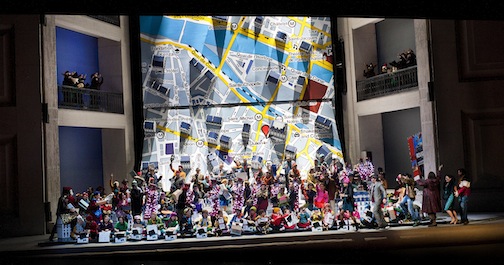 A nice touch was an invisible hand that scrawled the name of Mini on the fogged and steamed up window splattered with raindrops in the final scene. This was then blotted out implying Mimi's imminent demise. However this production was certainly not on par with the magnificent singing and orchestral playing which made this Boheme such a resounding success.
Opera only represents one of the art forms of the Festival, which also includes drama, solo recitals, visiting orchestras, and chamber music events. The new director also introduced a new series of sacred music, which will highlight different faiths in forthcoming festivals. This year, it was Judaism and the Israel Philharmonic under Zubin Mehta played a prominent part. Unfortunately I was not in Salzburg for their concerts but the IPO garlanded rave international reviews.
That incomparable pianist Maurizio Pollini gave a magisterial, cool but unemotional Apollonian account of Beethoven's last three piano sonatas. His playing was characterized by intellectual and technical brilliance and mathematical precision but was somewhat cold and distant. In three concerts, pianist Daniel Barenboim undertook a foray into Schubert's last piano works. In his exploration of these great compositions, in contrast to Pollini, he displayed a more passionate emotional Dionysian approach, capturing the essence of the composer. Barenboim's rendering of the four Impromptus (D935) was something to be remembered and cherished.
The current festival was highly successful. To date, almost 300,000 visitors have attended, the highest number since its inception in 1920. Over 90 percent of tickets for the 256 performances were sold.
Part of this review was published in The Jerusalem Post on Sept. 5, 2012
Illustrations
Fig 1: Die Soldaten, Ensemble. Credit Ruth Walz
Fig 2: Die Soldaten, Alfred Muff as Wesener and Laura Aikin as Marie. Credit Ruth Walz
Fig 3: La bohème with Piotr Beczala as Rodolfo and Anna Netrebko as Mimi. Credit Silvia Lelli
Fig 4: La bohème, Ensemble. Credit Silvia Lelli
Amongst the Jewish prisoners in the Theresienstadt concentration camp during the Second World War were distinguished scholars, scientists and artists. Despite adversity, dire inhumane circumstances and deportations to the death camp of Auschwitz, these prisoners organized many notable cultural events. Amongst the most memorable were performances of Verdi's Requiem under the direction of the Romanian conductor Rafael Schächter. This remarkable individual had at his disposal only a single printed copy of Verdi's composition. Thus every one of his 150-member chorus had to memorize the complex score by heart. Since there was no orchestra, accompaniment was provided by a legless upright piano propped up on boxes.
Rehearsals were held after the day's work. Choir members were exhausted and hungry but under Schächter's inspiration and charisma, these Jewish prisoners rose magnificently to the occasion. There were a total of 16 performances of the Requiem including one before Adolph Eichmann and a Red Cross delegation. The choir was decimated twice by deportations and the indefatigable Schächter had to recruit new volunteers and begin once again the process of teaching them their parts. Eventually Rafael Schächter himself was deported to Auschwitz where he was murdered. The Verdi Requiem was the prisoners' way of "singing to the Nazis what we cannot say to them," and represents a sterling and unique example of the answer to man's inhumanity to man.
Some years ago, the conductor Murry Sidlin, a former Dean of the Benjamin T. Rome School of Music at Catholic University of America in Washington DC, decided to commemorate these performances and to this end he conceived, directed and made commentaries in what is now known as The Defiant Requiem. This received a performance at the recent Israel Festival.
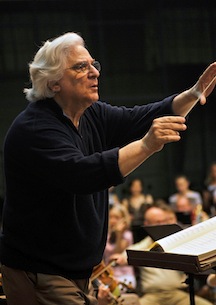 Sidlin has conducted The Defiant Requiem in several locations, most notably at Theresienstadt itself. His production takes the form of a multimedia drama combining Verdi's Requiem with video footage projected onto two large screens featuring spoken dialog from survivors of Schächter's original chorus as well as videos of the deportation and other unspeakable horrors of the Holocaust. Besides the video clips, there were also spoken commentaries by Murry Sidlin as well as from Israeli actors Sasson Gabai and Yona Elian. Dialog and videos were introduced between the movements of the Requiem. Only during the Agnes Dei (Lamb of God) was the music accompanied by Nazi propaganda clips about the camp.
An air of solemnity and dignity pervaded the whole experience. No applause greeted choir, orchestra, soloists and conductor on their entrance. Instead the audience were treated with a section of Bach's Chaconne, the concluding section of his second Partita for Violin played by the solitary first violinist of the Jerusalem Symphony Orchestra. This was perhaps a reminder to the audience of the rich and varied cultural environment in Theresienstadt despite the inhuman and barbaric conditions. Most of the sections of the Requiem were introduced on the piano, reminiscent of the Schächter performances when this represented the only musical accompaniment.
The most accomplished soloists were soprano Ira Bertman and tenor Yotam Cohen. Particularly noteworthy was Bertman's contribution to the concluding Libera Me (Deliver Me) section which she sang with passion and much conviction. The Kuhn Choir (Czech Republic) also acquitted themselves well. On occasion, the Jerusalem Symphony Orchestra sounded somewhat ponderous and laboured. However these minor deficiencies paled into insignificance when one considered the overall impression of this unforgettable emotional and musical experience.
At the end of the performance, darkness descended and there was a piecing whistle-like sound, implying the departure of the trains with their hapless Jewish inmates on the way to their death at Auschwitz. Slowly and silently, choir, orchestra, soloists and conductor exited leaving the lone violinist playing Oseh Shalom part of the traditional Jewish Kaddish (Mourner's Prayer) for the dead: "He who makes peace in his high holy places may he bring peace upon us, and upon all Israel." There was no applause. The audience stood for a moment in total silence and then slowly exited the auditorium.
The performance was shattering and without question, one of the highlights of the recent Israel Festival. This was a most unforgettable experience, which will forever be indelibly ingrained in my psyche. This is especially relevant today with the spectre of an imminent nuclear-armed Iran, a state that officially denies the Holocaust and has repeatedly called for Israel's annihilation.
Image: Murry Sidlin conducting the Defiant Requiem. Photo courtesy of Alex Irvine.
Careful nurturing is required to develop her formidable talent
The Israel Philharmonic Orchestra (IPO) featured the 12-year-old Israeli pianist, Maya Tamir, in its most recent subscription concert that was devoted to the music of Franz Joseph Haydn. This event was part of the IPO's Friday morning Intermezzo series at the Jerusalem Theater. Besides the music, the audience is also treated to coffee and cake. This concert series is introduced by well-known personalities. This time it was David Witzthum, author, pedagogue, and erudite TV editor and commentator. Witzthum gave a fascinating lecture on Haydn, replete with interesting anecdotes and quotes from Haydn, putting him into context to the music of the era and emphasizing his profound influence on the next generation of composers.
Maya Tamir played Haydn's piano concerto in D Major (Hob.XVIII:11). As can be seen on YouTube, this particular concerto is a frequent vehicle for prodigies. Tamir gave an insightful performance, her interpretation belying her age. At the outset, she was somewhat overwhelmed and displayed some anxiety, which probably accounts for some inconsistencies on the keyboard. However, she rapidly settled in. This was not a routine perfunctory run-through of a popular work, but a subtle interpretation with appropriate changes in tempo and dynamics. Her crescendos and diminuendos came at the right places and she blended in beautifully with the orchestra.
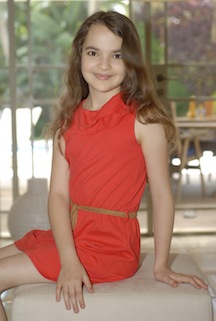 One could argue that the IPO was amiss to devote a full subscription series, comprising four concerts, to this young prodigy. To make the public aware of her exceptional talents is one thing, and certainly an occasional concert with the IPO or other orchestras would be in order. However to devote a full series requires a leap of faith and I am not sure it serves Tamir's long-term interests. All great artists begin their careers as prodigies. However not all prodigies become great artists. Careful nurturing by family, teachers and other professionals is required for her to fulfill her phenomenal talents. Too early exposure can be detrimental to her full artistic development.
Yoel Levi, currently principal conductor of the Orchestre National d'Ile de France, was on the podium and he provided sympathetic accompaniment for the soloist in the piano concerto. In the second half of the concert he gave a most respectful account of Haydn's symphony No 104, The London, the last work in this genre, which he composed.
The orchestra responded beautifully with lush string playing. Levi successfully brought out the development of Haydn as a great symphonist and under his baton, Beethoven's indebtedness to Haydn became readily apparent. There was also some lovely woodwind and brass playing in the second movement. Maybe a little lighter touch was called for in the third movement especially the trio, which sounded a bit ponderous. Levi concluded the performance with a lively account of the final allegro movement, which ended with a flourish. This was an apt conclusion to a most satisfying concert.
Illustration:
The young 12 year old Maya Tamir. Credit: Rami Mor.
This article was originally published in Esra Magazine, Issue No 165, 2012
Almost 2,000 years ago, the hallowed mountain of Masada was the site of the last stand of the Jews against the Romans, where about 1,000 fighters committed mass suicide rather than surrendering. This event is indelibly ingrained into the psyche of every Israeli.
Over the past two years, Masada has served as a backdrop to the Israel Opera productions of Nabucco and Aida. This year it was Bizet's Carmen. There were six performances including one dress rehearsal and a total of 50,000 people attended the production. Of these, 3,500 opera lovers came from overseas, specifically to attend the performances and the opening night was projected live at several sites all over Israel.
Israel Opera's productions at Masada represent the country's largest single cultural enterprise. The cost of this year's production was 30 million shekels (approximately $8.5 million) and ticket prices ranged from 350 to 1300 shekel.
The sheer logistics of this complex enterprise are mind-boggling. The work force comprised over 2,500 people. The huge cast of 400 performers included singers, flamenco dancers from Spain and adult and children's choirs. Because of the harsh and arid desert conditions, there were two alternating casts. Many of the principal roles were taken by major international singers but there were also prominent Israeli artists amongst the distinguished roster.
An amphitheatre seating 7,500 people together with a 3,500-square-meter stage is specially constructed for the event. It takes six months of hard work to organize all the logistics for this undertaking. After the performances, everything is dismantled to maintain an eco-friendly environment of Masada, which is a World Heritage Site.
The operatic extravaganza was directed by Giancarlo del Monaco Zuckerman and William Orlandi designed the sets which exploited the massive stage to the maximum. The incomparable setting with the backdrop of Masada is pure magic. In Act I, set in a square in Seville, the background behind the main protagonists was filled with couples walking arm in arm, and an endless parade of horses with riders and donkeys hauling ploughs and other farm implements. For a purist, this may represent overkill and the busy staging did to some extent detract from the main events unfolding center stage.
The staging of the tavern scene in Act 2 was impressive and the lighted braziers casting shadows gave a very authentic touch. Again it was very busy with revellers and smugglers. However in the intimate contact of Carmen and Don José, the giant stage was empty except for these two protagonists. In view of all the equestrian activity noted in Act 1, it was somewhat surprising that the bull fighter, Escamillo, made his entrance and exit on the shoulders of two members of his party.
Act 3 was also innovatively staged and featured a train together with rail tracks. The smugglers unloaded their contraband from the train. The first part of the final Act 4 is set outside the bullring in Seville and contained the expected large crowd of revellers and onlookers witnessing the dramatic parade of the matador's colorful entourage which even included a carriage drawn by horses.
However the final scene of Act 4, when Carmen is confronted by Don José, did raise some questions about the director's intent. Bizet's instructions call for the stage to be empty, all the spectators having entered the bullring for the matador's encounter with the bull. Here several hundred seated and standing spectators witnessed Carmen's gruesome and brutal stabbing.
Full marks go to choreographer Charlos Vilan, who brilliantly succeeded in exploiting the vast stage to the maximum with Spanish Flamenco dancers and child dancers and actors who performed at every conceivable opportunity, including the overture and the well-known introduction to Act 3.
The young Israeli mezzo soprano, Naama Goldman, a member of the Israeli Opera's Opera Studio and the recipient of an award from the America-Israel Cultural Foundation, was the scheduled understudy for this production. She took over the challenging title role of Carmen with four hours notice, when the scheduled mezzo called in sick. Not an easy task for a young singer in front of 7500 spectators.
Nevertheless Goldman rose to the occasion and acted and played the part with aplomb. With her good looks, flowing black hair and coquettish demeanour she proved herself to be a very authentic and believable Carmen. Her amplified voice projected well although there were some minor intonation problems with the lower registers. This was by all accounts a most auspicious debut for the young singer, who is destined for a great future. Soprano Brigitta Kele, in the role of Micaëla also made a good impression especially in the scene when she pleaded with Don José to return to see his dying mother.
Despite the hostile elements including wind and sand, and the relatively unprotected stage, from where I was sitting, the sound engineers appear to have done a magnificent job and orchestra and soloists could be clearly heard. Problems still remain with the vocal amplification of the choir. Daniel Oren who conducted the previous productions successfully brought out all the nuances of Bizet's score and was most sympathetic to his singers.
The Israel Opera deserve heartiest accolades for bringing off so successfully this ambitious production. Puccini's Turandot is scheduled for next year.
Illustrations
Fig 1: The Israel Opera production of Carmen. Photo credit: Yossi Zwecker
Fig 2: Israeli mezzo-soprano Naama Goldman flanked by Don José (Gustavo Porta) and Micaëla (Brigitta Kele) after her very successful debut at Israel Opera's production of Carmen. Photo credit: Irving Spitz
|
|
|




 Evelyn Herlitzius (Elektra) and Waltraud Meier (Klytämnestra) in Richard Strauss's Elektra. Credit Brescia/Amisano - Teatro alla Scala
Evelyn Herlitzius (Elektra) and Waltraud Meier (Klytämnestra) in Richard Strauss's Elektra. Credit Brescia/Amisano - Teatro alla Scala Concluding scene of Richard Strauss's Elektra. Credit Brescia/Amisano - Teatro alla Scala
Concluding scene of Richard Strauss's Elektra. Credit Brescia/Amisano - Teatro alla Scala Tenor Jose Cura and soprano Martine Serafin in Umberto Giordano's Andrea Chenier.
Tenor Jose Cura and soprano Martine Serafin in Umberto Giordano's Andrea Chenier.  Barione Marco Vratogna in Umberto Giordano's Andrea Chenier.
Barione Marco Vratogna in Umberto Giordano's Andrea Chenier. 